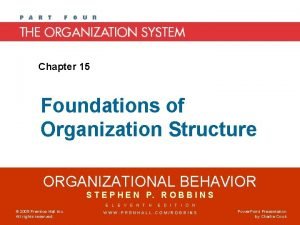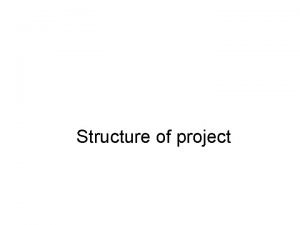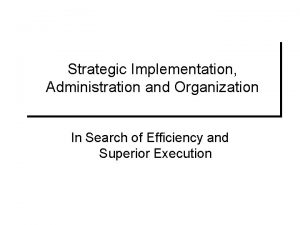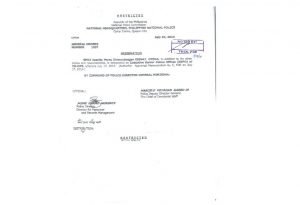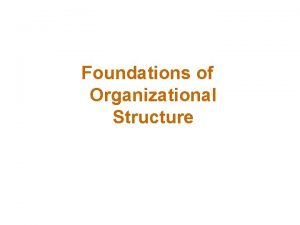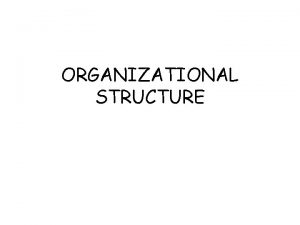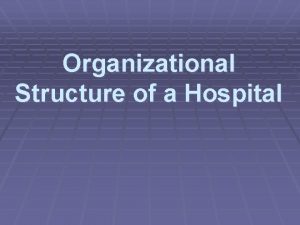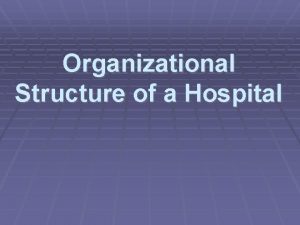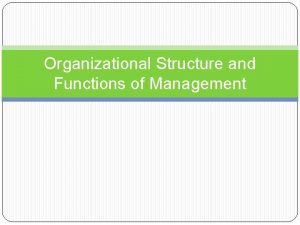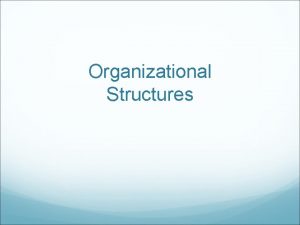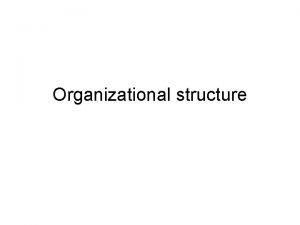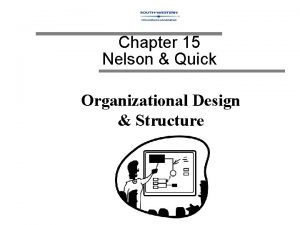Chapter 16 Foundations of Organizational Structure What Is























- Slides: 23

Chapter 16 Foundations of Organizational Structure

What Is Organizational Structure? Ø Organizational Structure – How job tasks are formally divided, grouped, and coordinated – Key Elements: 1. Work specialization 2. Departmentalization 3. Chain of command 4. Span of control 5. Centralization and decentralization 6. Formalization 16 -1

1. Work Specialization Ø The degree to which tasks in the organization are subdivided into separate jobs Ø Division of Labor – – – Makes efficient use of employee skills Increases employee skills through repetition Less between-job downtime increases productivity Specialized training is more efficient Allows use of specialized equipment Ø Can create greater economies and efficiencies – but not always… 3 -2

3 -3

2. Departmentalization Ø The basis by which jobs are grouped together Ø Grouping Activities by: – Function – Product – Geography – Process – Customer 3 -4

3. Chain of Command Ø Authority – The rights inherent in a managerial position to give orders and to expect the orders to be obeyed Ø Chain of Command – The unbroken line of authority that extends from the top of the organization to the lowest echelon and clarifies who reports to whom Ø Unity of Command – A subordinate should have only one superior to whom he or she is directly responsible 3 -5

3 -6

3 -7

5. Centralization and Decentralization Ø Centralization – The degree to which decision making is concentrated at a single point in the organization. Ø Decentralization – The degree to which decision making is spread throughout the organization. 3 -8

6. Formalization Ø The degree to which jobs within the organization are standardized. – High formalization • Minimum worker discretion in how to get the job done • Many rules and procedures to follow – Low formalization • Job behaviors are nonprogrammed • Employees have maximum discretion 3 -9

3 -10

Common Organizational Designs: Bureaucracy Ø Bureaucracy – A structure of highly operating routine tasks achieved through specialization, very formalized rules and regulations, tasks that are grouped into functional departments, centralized authority, narrow spans of control, and decision making that follows the chain of command 3 -11

An Assessment of Bureaucracies Ø Strengths – Functional economies of scale – Minimum duplication of personnel and equipment – Enhanced communication – Centralized decision making Ø Weaknesses – Subunit conflicts with organizational goals – Obsessive concern with rules and regulations – Lack of employee discretion to deal with problems 3 -12

Common Organizational Designs: Matrix Ø Matrix Structure – A structure that creates dual lines of authority and combines functional and product departmentalization Ø Key Elements – Gains the advantages of functional and product departmentalization while avoiding their weaknesses – Facilitates coordination of complex and interdependent activities – Breaks down unity-of-command concept E X H I B I T 16 -5 3 -13

New Design Options: Virtual Organization – A small, core organization that outsources its major business functions – Highly centralized with little or no departmentalization • Provides maximum flexibility while concentrating on what the organization does best • Reduced control over key parts of the business 3 -14

New Design Options: Boundaryless Organization – An organization that seeks to eliminate the chain of command, have limitless spans of control, and replace departments with empowered teams – T-form Concepts • Eliminate vertical (hierarchical) and horizontal (departmental) internal boundaries • Breakdown external barriers to customers and suppliers 3 -15

3 -16

Four Reasons Structures Differ 1. Strategy – Innovation Strategy • A strategy that emphasizes the introduction of major new products and services • Organic structure best – Cost-minimization Strategy • A strategy that emphasizes tight cost controls, avoidance of unnecessary innovation or marketing expenses, and price cutting • Mechanistic model best – Imitation Strategy • A strategy that seeks to move into new products or new markets only after their viability has already been proven • Mixture of the two types of structure 3 -17

Why Structures Differ 2. Organizational Size – As organizations grow, they become more mechanistic, more specialized, with more rules and regulations 3. Technology – How an organization transfers its inputs into outputs • • The more routine the activities, the more mechanistic the structure with greater formalization Custom activities need an organic structure 4. Environment – – Institutions or forces outside the organization that potentially affect the organization’s performance Three key dimensions: capacity, volatility, and complexity 3 -18

3 -19

3 -20

3 -21

3 -22
 Foundations of organizational structure
Foundations of organizational structure Sbu m-form structure
Sbu m-form structure Chapter 7 designing organizational structure
Chapter 7 designing organizational structure Chapter 7 designing organizational structure
Chapter 7 designing organizational structure Foundations of a healthy relationship
Foundations of a healthy relationship Chapter 6 lesson 1 foundations of a healthy relationship
Chapter 6 lesson 1 foundations of a healthy relationship Describe the care team and the chain of command
Describe the care team and the chain of command Foundation of individual behavior
Foundation of individual behavior Chapter 1: foundations of government
Chapter 1: foundations of government Chapter 4 foundations background to american history
Chapter 4 foundations background to american history Foundation in personal finance chapter 1 answers
Foundation in personal finance chapter 1 answers Ultimate frisbee vocabulary
Ultimate frisbee vocabulary Chapter 1: foundations of government pdf
Chapter 1: foundations of government pdf Foundations of government (chapter 1 test form a)
Foundations of government (chapter 1 test form a) Pure project structure
Pure project structure Unitary form organizational structure
Unitary form organizational structure Shamrock structure
Shamrock structure Riot games organizational structure
Riot games organizational structure Organizational structure of ethiopian airlines
Organizational structure of ethiopian airlines Matrix project organizational structure
Matrix project organizational structure Organizational structure of bfp in the philippines
Organizational structure of bfp in the philippines Philippine national police organizational structure
Philippine national police organizational structure Sgc organizational structure
Sgc organizational structure Bangladesh bank organogram
Bangladesh bank organogram
